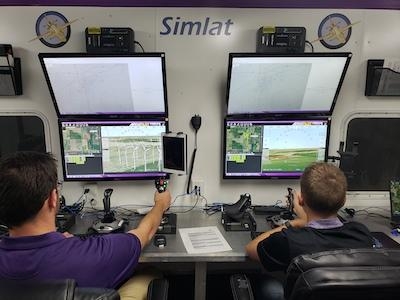Kansas State University Polytechnic Campus Applied Aviation Research Center Joins Forces With Simlat
The Kansas State University Polytechnic Campus Applied Aviation Research Center has partnered with Simlat, an unmanned aircraft systems simulation company, to provide beyond visual line of sight simulator training.

As part of a partnership with the Kansas Department of Transportation, the simulators will initially be used to train partners involved in the Unmanned Aircraft Systems Integrated Pilot Program through the Federal Aviation Administration. With a large focus on beyond line of sight operations, participants in the course will receive a comprehensive training experience on both simulation and live flight events.
The UAS Integrated Pilot Program was established to utilize the research and expertise of national partners to shape the future of unmanned aircraft in America. The Kansas Department of Transportation is one of only nine participants competitively selected from hundreds of applicants in the UAS Integrated Pilot Program nationwide.
In 2018, Kansas State Polytechnic was the first university to receive a waiver from the Federal Aviation Administration to administer UAS training beyond line of sight. The purchase of these simulators and partnership with Simlat expands the knowledge base of Kansas State Polytechnic instructors and training offerings, allowing for additional cutting-edge research of drones in U.S. airspace.
"Simlat's technology allows us to create a highly realistic representation of the operational environment in which we will be conducting our beyond line of sight operations," said Kurt J. Carraway, UAS executive director of the Applied Aviation Research Center at Kansas State Polytechnic Campus. "The use of the simulator enables our flight instructors to control environmental conditions and inject anomalies into simulated unmanned aircraft systems to provide initial, abnormal and emergency scenarios to ensure our pilots are trained to respond correctly should these instances occur in live flight. Simlat did a great job in working with us to create a very realistic environment for our operations."
Kansas State Polytechnic's beyond visual line of sight training program is a seven-day immersive course in which participants receive a series of ground instruction and hands-on flight instruction. The simulator training allows course participants to build flight plans and transition seamlessly from simulation to actual live flight. The flexibility of the Simlat simulators allows instructors to program diverse flight conditions and various flight scenarios such as system failures and environmental and weather conditions.
The educational mission of Kansas State Polytechnic includes real-world, hands-on experiences to ensure students are equipped with the necessary skills to have an immediate impact on industry upon graduation. To further this mission, this beyond visual line of sight simulation training curriculum established by the Applied Aviation Research Center will eventually expand to include Kansas State Polytechnic's UAS degree program offerings.
An Association for Unmanned Vehicle Systems International award winner and national expert in the UAS industry, Kansas State Polytechnic is known as a top provider of UAS training. The addition of these simulators will provide for the development of another facet of UAS training provided by Kansas State Polytechnic, Carraway said.
A global leader in UAS simulation, Simlat is a leading provider of innovative, next-generation training solutions. These training solution systems enable training for any platform, payload and mission. As part of this established partnership between Simlat and Kansas State Polytechnic, Simlat produced a simulation environment specific to Kansas, allowing for detailed beyond visual line of sight operations within a local environment. This allows for pilots, training participants and students to develop a flight plan with a direct transition from simulator to aircraft.
"We are honored to participate in this important Integrated Pilot Program and look forward to a long-term relationship with Kansas State Polytechnic's prestigious UAS program," said Roy Peshin, Simlat's chief technology officer.
(Image provided with Kansas State Polytechnic news release)
 Aero-News: Quote of the Day (11.27.25)
Aero-News: Quote of the Day (11.27.25) Airborne 11.26.25: Bonanza-Baron Fini, Archer v LA NIMBYs, Gogo Loses$$$
Airborne 11.26.25: Bonanza-Baron Fini, Archer v LA NIMBYs, Gogo Loses$$$ FAA Seeks Info For New Brand-New ATC Platform
FAA Seeks Info For New Brand-New ATC Platform USAF Reaper Drone Crashes Off the South Korean Coast
USAF Reaper Drone Crashes Off the South Korean Coast Hartzell Engine Tech Magneto Gains FAA-PMA
Hartzell Engine Tech Magneto Gains FAA-PMA



